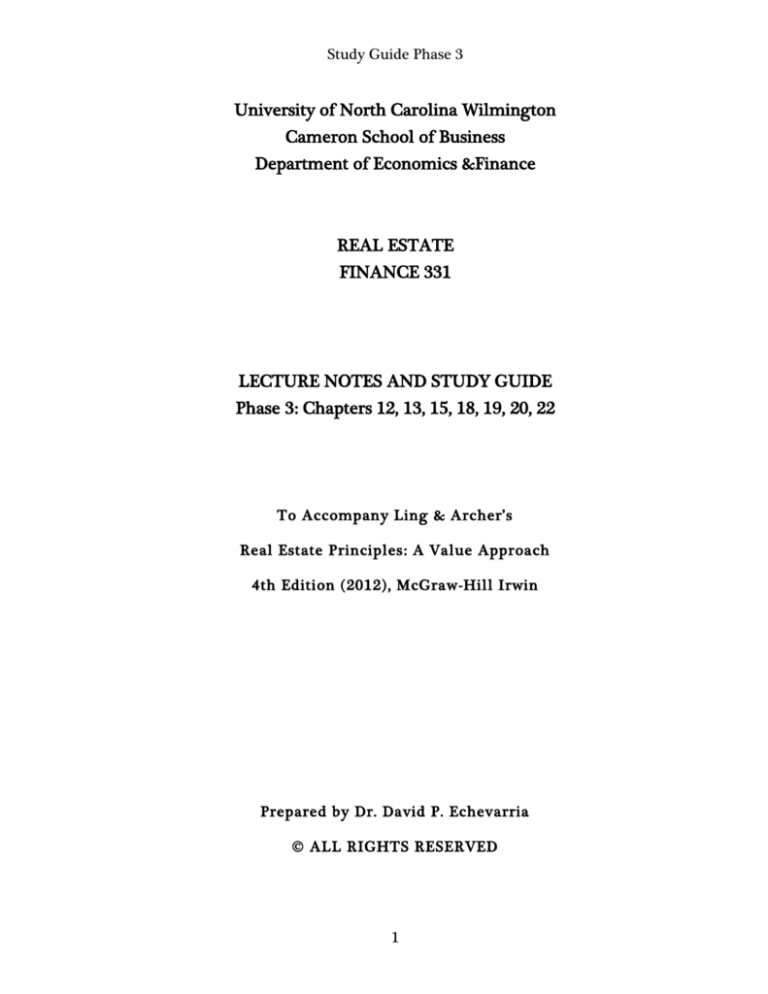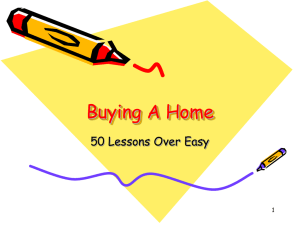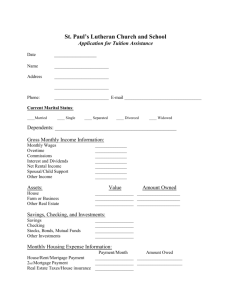
Study Guide Phase 3
University of North Carolina Wilmington
Cameron School of Business
Department of Economics &Finance
REAL ESTATE
FINANCE 331
LECTURE NOTES AND STUDY GUIDE
Phase 3: Chapters 12, 13, 15, 18, 19, 20, 22
To Accompany Ling & Archer’s
Real Estate Principles: A Value Approach
4th Edition (2012), McGraw-Hill Irwin
Prepared by Dr. David P. Echevarria
ALL RIGHTS RESERVED
1
Study Guide Phase 3
Chapter 12
Real Estate Brokerage and Listing Contracts: A Brief Review
I.
REAL ESTATE BROKERAGE
Brokers are intermediaries: they bring buyers and sellers together
Brokers charge commissions for their services
Law of agency: broker or salesperson serves as principal for client
Brokers have a fiduciary responsibility to their clients
1. Maintain confidentiality
2. Follow the instructions of their principal
3. Keep principal informed of all financial aspects
4. Don’t subordinate interest of principal to others
5. Disclose all relevant information to the principal
6. Always represent the interest of their principals to the best of their ability
Agency relationship begins with a listing contract
1. Open listing: property may be listed with other brokers (MLS)
2. Exclusive agency listing: owners may sell the property without paying commission
3. Exclusive right of sale listing: broker gets commission regardless of who sells the
property
II.
HOMEWORK ASSIGNMENT
Key terms: Fiduciary Relationship, Law of Agency, Open Listing, Principal, Subagency,
Universal agent
Test Problems: 1, 3, 4, 7
2
Study Guide Phase 3
Chapter 13
Contracts for Sale and Closing
I.
REQUIREMENTS OF THE CONTRACT FOR SALE
A [written] contract for sale must contain the following elements
1. Competent parties: parties must be of minimum legal age
2. Legal objective: contract objective must be legal
3. Offer and acceptance: contract binds parties to specific actions in the future
4. Consideration: the value given up by each party to the contract
5. No defects to mutual assent: the contract may be broken if there are defects
6. a proper legal description of the property
Forms of Title
7. Legal title: ownership of a freehold estate
8. Equitable title: grants the right to obtain legal title
II.
FORM OF THE CONTRACT FOR SALE
Elements of a simple contract
1. Determines price and terms of the transaction
2. Defines property interest being conveyed
3. Determines the grantee and grantor
Elements of a complete contract (see Exhibit 13 – 1)
1. Parties to the contract
2. Description of the property (includes legal description)
3. Purchase price
4. Time for acceptance of offer and counter offers
5. Closing date
6. Date of the contract
7. Date and Place of closing
8. Financing terms of any
9. Prorating of costs and expenses
10. Required inspections and disclosures relevant to the property
11. Assurance of good and marketable title
12. Remedies for breach of contract
3
Study Guide Phase 3
13. Responsibilities of the escrow agent and broker
14. Earnest money deposit (consideration)
Rationale for written contracts
15. Reduce chances for fraud
16. Avoid the possibility of promissory estoppel
Contract Terminology
1. Contingent contract: Obligation of a party to perform depends on one or more
conditions being met
2. Assignment: One party’s contractual rights and obligations are transferred to
someone else
a. Does not relieve assignor of liability
b. Can be explicitly prohibited
3. Escrow agent: Third party who holds moneys or documents on behalf of contract
parties
a. Distributes items in accordance with contract
b. Can be attorney, financial institution, or title company
III.
REMEDIES FOR NONPERFORMANCE
Suit for damages: Always an option to both parties
Rescission: both parties agree to return to pre-contract status
Specific performance: Buyer can force seller to convey title
Liquidated damages (seller): Seller can retain deposit if buyer backs out
Rescission: Mutual agreement to cancel
IV.
REAL ESTATE SETTLEMENT PROCEDURES ACT
Applies to virtually every home loan:
1. Loans from federally chartered or insured institutions
2. FHA and VA loans
3. Loans to be sold to Fannie Mae or Freddie Mac
Requirements:
1. Borrower to be provided information booklet
2. Borrower receives good faith estimate of closing costs
3. Closing statement must be HUD-1 form
4. Closing statement available 24 hours before closing
5. Kickbacks to closing-related vendors are prohibited
4
Study Guide Phase 3
6. Limit to lender escrow deposit requirement
Pre-closing requirements
1. Good faith estimates the buyers closing costs
2. Check property for encroachments
3. Review zoning
4. Property inspected; include termite inspection
5. Verify seller’s required actions
Pre-closing actions of closing agent
1. Prepare or obtain general warranty deed
2. Prepare mortgage and note
3. Prepare check from lender to the seller
4. Prepare HUD-1 closing statement
5. Obtain satisfaction of mortgage from sellers’ mortgagee confirming balance
Financial items in the closing
1. Purchase price
2. Earnest money deposit
3. Assumed mortgage
4. Purchase money mortgage
5. Prorated Items
6. Interest on assumed mortgage
7. Existing insurance
8. Property taxes
9. Title insurance
10. Attorneys
11. State document tax
Post Closing actions
1. Regarding the new mortgage
2. Record the deed
3. Pay brokerage commissions
5
Study Guide Phase 3
V.
HOMEWORK ASSIGNMENT
Key terms: Assignment, Consideration, Earnest money, Equitable title, Escrow, Legal
title, Prorating, Rescission, Specific performance
Study Questions: 5, 7, 9
1. How is the pro rata of miscellaneous charges accomplished? Example: insurance
premiums, water and sewer charges, property taxes: review study questions one
through four
6
Study Guide Phase 3
Chapter 15
Mortgage Calculations and Decisions
I.
FIVE VITAL FEATURES OF A MORTGAGE
Principal amount
Term to maturity
Interest rate
Monthly payment
Amortization schedule
II.
BASIC MORTGAGE COMPUTATIONS
Using the Texas Instrument BA II Plus financial calculator
1. Mortgage calculations require 4 of the six basic functions
a. Number of payments (N)
b. Interest rate per year (I/Y) (P/Y must be set to 12 for a standard mortgage)
c. Loan amount (PV: present value equals about the loan)
d. Monthly payment (PMT)
e. Value of the mortgage at maturity (FV)
f. Compute (CPT)
2. Preparing the Amortization Schedule
a. Using the AMORTization function (a second function of the PV key)
b. Set the P1 and P2 values to one
c. Press the down key []
d. Read the BALance
e. Press the down key []
f. Read the PRiNcipal
g. Press the down key []
h. Read the INTerest
i. Press the down key []
j. Press the compute key (CPT): P1 and P2 values will increment to the next payment
k. Repeat steps starting with “c”
7
Study Guide Phase 3
III.
HOMEWORK ASSIGNMENT
Key terms: Annual Percentage Rate (APR), Discount points, Effective Borrowing Costs,
Lenders Yield, Amortization
Study Questions: 1, 2, 6, 7, 10, 16
8
Study Guide Phase 3
Chapter 18
Investment Decisions: Ratios
I.
INVESTMENT DECISION-MAKING
The difference between Investment Value and Market Value
1. Market Value reflects the value of the land and structures thereon
2. Investment Value takes into consideration future income streams resulting from the
acquisition of a property
a. Rental rates
b. Vacancy rates
c. Operating expenses
d. Potential future capital investment
e. Risk attributes
Estimating net operating income for the next year
PGI
Potential Gross Income
-
VC
Vacancy & Collection Loss
+
MI
Miscellaneous Income
= EGI
-
OE
CAPX
Effective Gross Income
Operating Expenses
Capital Expenditures
= NOI
Net Operating Income
-
Debt Service
DS
= BTCF
Before-Tax Cash Flow
- TAX
= NI
Fed, State, Local Taxes
Net Income
Operating vs. Capital Expenditures
1. Operating expenses:
a. Keep property operating & competitive
b. Do not increase value or extend useful life
c. Examples: minor roof repairs, air conditioner servicing, lawn maintenance, utilities, etc.
9
Study Guide Phase 3
2. Capital Expenditures:
a. Increases market value of property
b. Examples: Roof replacement, air-conditioner replacement, installation of new
landscaping
3. Some Treat CAPX as a Reserve (above the line), some below the line
a. Below: PGI – VC = EGI – OE – CAPX = NOI
b. Above: PGI – VC = EGI – OE = NOI – CAPX = NCF (Net Cash Flow)
c. Note: CAPX is not a tax deductible “expense”: it gets amortized as depreciation
4. NOI must be sufficient to:
a. Service the mortgage debt and
b. Provide investor with an acceptable return on equity
II.
FINANCIAL RISK RATIOS (SEE EXHIBIT 18 – 6)
Operating Expense Ratio = Operating Expenses divided by Effective Gross Income
Loan-to-Value Ratio = Loan divided by Fair Market Value
Debt Coverage Ratio = Operating Income divided by Debt Service
Debt Yield Ratio = first year NOI divided by the first mortgage loan
III.
HOMEWORK ASSIGNMENT
Key terms: after-tax cash flow, net income multiplier, operating expense ratio,
capitalization rate, effective Gross income multiplier, Effects of Leverage
Test Problems: 8, 9, 10
Study Questions: 1, 2, 3, 7, 9, 10, 12
10
Study Guide Phase 3
Chapter 19
Investment decisions: NPV and IRR
I.
INVESTMENT VALUATION VERSUS MARKET VALUATION
Most commercial real estate decisions involve investment motive
1. Investments are made in expectation of future cash flows
2. The magnitude and timing of future cash flows will determine whether or not an
investment is profitable or not
3. The Discounted Cash Flow method (DCF) is used to determine the feasibility of an
investment
Required inputs for DCF analysis
1. Estimate how long the investor will hold the property
2. Estimate the yearly net cash flows
3. Select an appropriate risk-adjusted discount rate to complete the calculations
4. DCF process will yield a net present value (NPV)
NPV decision rules
1. NPV = Present Value of ATCF minus the Initial contact Investment
2. If NPV is greater than 0, we make the investment
3. If NPV is less than 0, we will not make the investment
Measuring the impact of leverage
1. Leverage involves the use of debt to finance part of the acquisition
2. The interest charges on debt will reduce our taxable income
3. Traditional analysis uses ATCF values to compute NPV
Internal Rate of Return (IRR)
1. When NPVs are greater than 0, the internal rate of return will be greater than the
discount rate used to compute NPV
2. If NPV is equal to 0, then the internal rate of return equals the discount rate
3. If NPV is less than 0, then the IRR is less than the discount rate
11
Study Guide Phase 3
II.
MEASURING THE IMPACT OF RISK ON NPV
Sensitivity analysis
1. Most likely scenario
2. Worst-case scenario
3. Best-case scenario
Value of computer
1. Excel spreadsheets
2. Specialized software such as ARGUS
Monte Carlo simulation (using random probabilities to develop outcome distributions)
III.
HOMEWORK ASSIGNMENT
Key terms: before tax cash flows, after-tax equity reversion, leverage, levered cash flow,
unlevered cash flow
Study questions: 2, 3, 5, 9, 11
12
Study Guide Phase 3
Chapter 20
Income Taxation and Value
I.
OVERVIEW OF REAL ESTATE TAXATION
What the objectives of tax law and taxation?
What are the classifications of Real Property?
What are the forms of ownership and how are they taxed?
1. Sole Proprietors
2. Limited Liability Partnerships (LLP)
3. Limited Liability Companies (LLC)
4. Corporations
Who Finances Commercial Real Estate Deals?
What specifications are in the IRS Tax Code?
1. Passive Income
2. Interest Expense
3. Capitalization
4. Taxation of periodic Income
5. Taxation of Income from Sale
What Special Topics affect Property Management?
1. Tax Credits
2. Like-kind Exchanges
3. Tax treatment of home ownership
II.
TAX LAW OBJECTIVES
Raise revenues for Federal and State Governments
Promote socially desirable activities
1. Construction and rehabilitation of housing for low-income households
2. Rehabilitation of historic structures.
III.
CLASSES OF REAL ESTATE PROPERTY
For purposes of federal income taxes real estate has four categories
1. Personal residences
2. Dealer property
3. Trade or Business property
13
Study Guide Phase 3
4. Investment property
Depreciation and Federal Taxes
1. When permitted, depreciation allows investors to reduce their taxable income
2. Depreciation recognizes the economic wear and tear of commercial properties over
time: included are dealer, trade or business, or investment properties
3. Personal residences cannot be depreciated for tax purposes
4. Trade or business real estate is tax in accordance with section 1231 of the federal tax
code
5. Investment real estate is held primarily for capital appreciation, not rental income
and as such cannot be depreciated for tax purposes
IV.
FORMS OF OWNERSHIP AND TAXATION ISSUES
Considerations related to the form of ownership
1. Federal income tax issues
2. Avoiding personal liability for the debts and obligations of the business entity
3. Control issues related to management
4. Ability of the business entity to tap the debt and equity markets
5. Ability to share investment risk with other investors
6. Ease with which investors may dispose of their interests in said properties
General Partnerships
1. Pros
a. Taxable income and losses flow directly the individual partners and avoids double
taxation of income
b. Partnerships are easy to create
c. Partners make all the operating decisions: how much leverage to use and when to dispose
of the assets
d. Each partner’s share of income, losses, and cash flow determined by the partnership
agreement
e. Partnerships can allocate cash flow and tax liabilities differently for each partner to
reflect their interest in the partnership
2. Cons
a. All general partners are liable for all debts of the partnership including contractual debts
and debts due to legal actions against the partnership
b. General partners are also liable for wrongful acts committed by other partners in the
course of business
c. Due to unlimited liability of general partners, the personal assets of the partners are
14
Study Guide Phase 3
subject to claims with the partnership creditors
Limited Partnerships
1. Pros
a. A limited partnership introduces the trade-off by creating two distinct types of partners;
the General partner and the Limited partner
b. The Limited partner can limit their personal liability to an amount equal to their
investment in the partnership
2. Cons
a. Limited partnerships give up control of the partnership
b. Limited partners are prohibited from participating in management and policymaking
c. Limited partners totally reliant on the general partner to make decisions on their behalf
d. The relationship of the Limited partner to the general partners is essentially one of
principle and agent
C-Corporations
1. Pros
a. The Corporation is a legal and taxable entity separate from the owners/shareholders
b. The Corporation earns income and incurs tax liabilities
c. Corporations limit the liability of shareholders to the amount of their investment in the
corporation’s stock
2. Cons
a. Dividends paid to shareholders are not a deductible expense and are taxable as income to
the shareholders
b. The double taxation of dividends results in effective tax rates on income from properties
held by corporations to run as high as 60%. State taxes can push this percentage even
higher rendering corporate ownership less profitable
c. Corporate managers may or may not own stock in the company. This gives rise to the
agency problem; managers may not always act in the best interest of stockholders
S-Corporations
1. Pros
a. S-corporations are a separate legal entity
b. Provides for limited personal liability of shareholders
2. Cons
a. S-corporations are not a separate taxable entity: Taxable income passes directly to the
stockholder/owners
b. Limits the total number of stockholders to 100
c. Personal liability may arise if the corporate veil is waived in a court proceeding
15
Study Guide Phase 3
Limited Liability Companies (LLC)
1. Pros
a. Limited liability for the investors
b. Offer better tax advantages to owners: can elect to be taxed as a sole proprietorship,
partnership, C- or S-corporation; select best to avoid double taxation
c. These forms of ownership allow the cash flows and related tax liabilities to flow through
directly to the investor taxpayer
d. Greater flexibility in terms of the number of owners
e. LLC’s may permit all owners to participate in management; determined by the operating
agreement
f. Fewer compliance issues: example – no requirement for annual meeting
g. Perpetual existence like a corporation
2. Cons
a. Owners incur “pass-through” taxation; profits and losses reported to IRS on each owner’s
Schedule K form.
b. Raising capital may be more difficult; lack of corporate structure
c. Pass-through income may be subject to state income taxes plus many states impose a
franchise tax or “capital values tax”.
d. Less structure in governing business decisions requires a detailed operating agreement
Tenancy-in-Common (TIC)
1. Pros
a. Provides for direct ownership of the property by the investors as opposed to indirect
ownership in the previously described forms of business
b. Each co-owner has an undivided interest in the property; each co-owner receives a
separate deed.
c. TIC investors share pro rata periodic cash flows, tax consequences, and price
appreciation
d. May avoid taxes on capital gains if they exchange for “like-kind” property: See section
1031 of the IRS code
2. Cons
a. The number of investors cannot exceed 35
b. Syndication fees and other upfront expenses may consume up to 25% of industrial equity
c. Investors are subject to joint and several liability for the debts of the TIC; liability is not
limited to the amount of their equity investment
d. Many decisions require the unanimous approval of all investors; for example when to
sell the properties
16
Study Guide Phase 3
V.
ALTERNATIVE FORMS OF OWNERSHIP
Direct Investment:
1. Purchasing individual properties in the private market
2. Investors own the properties directly
Indirect investment
1. Pension funds: a portion of savings may be invested in real estate companies
2. Life insurance companies: a portion of premium payments invested in real estate
3. Real Estate Investment Trusts (REIT)
VI.
SOURCES OF REAL ESTATE FINANCING
Institutional and individual investors; hold 74% of all outstanding mortgage debt
1. Commercial banks: largest single source of private mortgage funds (54% in 2011)
2. Life insurance companies: provide approximate 13%
3. GSE’s provide approximately 11%
4. Savings institutions provide proximally 7%
5. The remaining 15% held by various Federal, State and local governments, Pension
Funds, and other unclassified entities.
Commercial Mortgage Backed Securities (CMBS)
1. CMBS backed by a pool of commercial mortgages
2. Offer premium yields over comparable government and corporate bonds
3. CMBS provides liquidity for mortgage originators by attracting nontraditional
investors into the commercial real estate mortgage market
VII.
INCOME SUBJECT TO TAXATION
Three types of income are subject to federal taxation
1. Active income: income earned from salaries, wages, commissions, and bonuses
2. Portfolio income: interest and dividend income on investments such as bonds and
stocks
3. Passive income: all income generated from rental real estate investments regardless
of whether or not the investors are managing the property or properties
Significance of Passive Activity Loss (PAL) restrictions
1. Tax losses from passive activities can be used to offset positive taxable income from
other passive activities
2. PAL’s cannot be used to offset active or portfolio income
17
Study Guide Phase 3
3. Excess passive losses can be carried forward indefinitely: it can be used offset future
passive income
4. Exceptions: regular corporations and non-corporate taxpayers who actively manage
residential rental investments subject to a $25,000 limit
5. Active income, portfolio income, and passive income are taxed at ordinary tax rates
6. Gains from property value appreciation eligible for favorable capital gain tax
treatment
VIII.
ESTIMATING TAX LIABILITIES FROM OPERATIONS
Eligible Deductions
1. Operating expenses
2. Above the line capital expenditures
3. Depreciation
4. Interest expense
Taxable Income is the Effective Gross Income minus Eligible Deductions
1. After-Tax Cash Flow (ATCF): a critical input to determine investment value via DCF
2. ATCF is different from net income in that it recognizes the impact of non-cash
expenses
Capital Improvements
1. Capital Expenditures above the line maintain the value the property and as such are
tax deductible
2. Capital Expenditures below the line are meant to increase the value the property and
as such are capitalized
3. Capitalized expenditures are added to the tax basis of the property and then expensed
by annual depreciation charges
Depreciable Basis
1. Original cost plus and the expenses incurred in acquiring the property such as
brokerage and legal fees
2. The land component of the original cost basis is not depreciable
3. Additional complications: real property (the building structure) and personal
property
4. Personal property includes such things as window air conditioners, refrigerators and
microwave ovens, wall and floor coverings, swimming pools and tennis courts
5. Personal property is any tangible property not part of the building’s core structure
18
Study Guide Phase 3
Cost Recovery Periods (Depreciation)
1. Residential income producing property not less than 27 ½ years
2. Nonresidential income producing property is 39 years
3. Personal property such as carpeting and draperies 3 years
4. Office equipment and fixtures 7 years
5. Landscaping and sidewalks 15 years
6. Three methods for depreciating property
a. Straight-line
b. 200% Declining Balance
c. Modified ACRS
Tax Credits
1. Renovating or rehabilitating certain older or historic structures
2. Construction and rehabilitation of qualified low-income housing
3. Tax credits reduce the tax liability on a dollar for dollar basis
IX.
ESTIMATING TAX LIABILITIES FROM SALE
Fully taxable sale treatment: when seller receives full payment in year of sale and
taxable gains are fully recognized for tax purposes in the year sale
Tax-deferred arrangements: when a portion of the sales proceeds and realized taxable
gains are not fully recognized until a later year, if ever
Adjusted basis: original cost basis plus any additional real property or personal property
capital expenditures minus the cumulative amount of tax depreciation taken since the
property was put in service
Calculating Cash Flow from Sale
1. Selling price
2. Minus selling expenses
3. Equals net sale proceeds
4. Minus remaining mortgage balance
5. Equals before tax equity reversion
6. Minus taxes due on sale
7. Equals after-tax equity reversion
Calculating the Adjusted Basis
1. Cost of land
2. Plus cost of building to include personal property
19
Study Guide Phase 3
3. Plus acquisition expenses
4. Equals original cost basis
5. Plus additional capital expenditures
6. Minus depreciation recapture
7. Equals adjusted basis
Calculating the Taxable Gain or Loss on Sale
1. Net sale proceeds
2. Minus adjusted basis
3. Equals total gain/loss
Calculating Taxes Due on Sale
1. Net sale proceeds
2. Minus adjusted basis
3. Equals taxable gain
4. Minus depreciation recapture
5. Equals capital gain
6. Plus depreciation recapture tax (maximum 25% rate)
7. Equals taxes due on sale
X.
LIKE-KIND EXCHANGES
A popular option for deferring capital gains taxes
Section 1031 of the Internal Revenue Code allows owners of real estate, under certain
circumstances, to exchange their properties for other properties to avoid paying some or
all of the taxes that would ordinarily be paid in the year of the transaction
Requirements for Like-Kind exchanges
1. Properties must be trade or business properties or investment property such as land
2. The properties in an exchange must be like kind properties
a. Real estate cannot be exchanged for personal property
b. Apartment buildings can be exchanged for office buildings, office buildings are shopping
centers, shopping centers for industrial warehouses and the like
c. US property must be exchanged for US property
d. Any cash or personal property received in the exchange is generally fully taxable in the
year of the exchange
20
Study Guide Phase 3
XI.
SUMMARY
Federal income taxes affect virtually all real estate transactions. The formal ownership is
a principal consideration in tax planning. A principal objective is to select form of
ownership that avoid double taxation of income.
Tax shelter benefits arising from direct ownership of real estate are realized mainly
through allowances for tax depreciation. Depreciation deductions, being non-cash expenses,
result in lower annual taxable incomes.
Tax credits resulting for rehabilitation of older nonresidential structures can also be
used to reduce tax liabilities. Properties with historical significance allows for up to 20% of
all re-habilitation expenditures be taken as a tax credit, subject to passive activity loss lots.
Tax credits are also available to qualified investors in low-income housing.
Real estate investors and two basic options for tax treatment when they sell property.
The options are a fully taxable sale treatment or a like kind exchange.
XII.
HOMEWORK ASSIGNMENT
Key Terms: Active Income, Passive Income, Dealer Property, Depreciable Basis,
Investment Property, Like-Kind Exchanges, Original Cost Basis, Section 1231 Property,
Trade/Business Property
Test Problems: 2, 5, 7, 8
Study Questions: 3, 4, 5
21
Study Guide Phase 3
Chapter 22
Leases and Property Types
I.
ESSENTIAL ELEMENTS OF THE LEASE
The names of the landlord and tenant
The description of the leased premises
An agreement to transfer possession of the property
The start and end dates of the agreement
A description of the rental payments
The agreement must be in writing
The agreement must be signed by all parties
II.
NEGOTIATED LEASE PROVISIONS
Use of the premises
The lease term to include an allowance for tenant improvements
Magnitude of the rental payments
Responsibility for operating expenses
Any concessions to be made by the lessor
Ability to assign or sublet the lease
Renewability of the lease
Cancellation option
Advertising and signage
Parking
Subordination and non-disturbance
III.
RESIDENTIAL RENTAL PROPERTIES AND LEASES
Common lease provisions
1. Lease term
2. Condition of premises
3. Responsibility for utilities
4. Rules and regulations
22
Study Guide Phase 3
IV.
OFFICE PROPERTIES AND LEASES
Class A properties: command higher rents because of location, desirability
Class B properties: command lower rents Class A properties
Defining rentable space
1. Usable area: Square footage of the bounded space
2. Rentable area: usable area plus a prorated share of the common areas
Common lease provisions
1. Lease terms
2. Expense Stops
V.
RETAIL PROPERTY CHARACTERISTICS
Shopping Centers
1. Strip malls
2. Shopping centers
3. Regional malls
4. Outlet centers
Defining leasable area
1. Gross Leasable Area
2. Gross Floor Area
Anchor Tenants: large department stores usually found at the corners of regional malls
Percentage Rent Clause: when rents are related to the tenant’s gross sales
Use Clauses
Hours of Operation
Common Area Maintenance
VI.
INDUSTRIAL PROPERTIES
Types of Properties
1. Single user buildings
2. Warehouses and Self-Storage facilities
3. Multitenant industrial parks
Tax-free zones
1. Industrial parks special tax breaks
23
Study Guide Phase 3
VII.
HOMEWORK ASSIGNMENT
Key terms: Anchor tenant, Cancellation option, Concessions, Percentage rent, Rentable
area, Right of First Refusal, Sublease, Tenant improvement allowance, Usable area
Test Problems: 5, 9
Study Questions: 4, 5, 6
24









